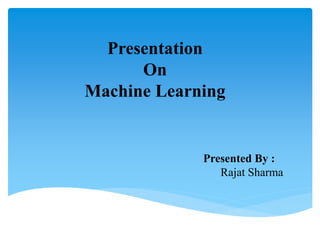
Machine learning ppt
- 1. Presentation On Machine Learning Presented By : Rajat Sharma
- 2. 1. History of Machine Learning. 2. What is Machine Learning. 3. Why ML. 4. Learning System Model. 5. Training and Testing. 6. Performance. 7. Algorithms. 8. Machine Learning Structure. 9. Application. 10. Conclusion. Outline
- 3. The name machine learning was coined in 1959 by Arthur Samuel Tom M. Mitchell provided a widely quoted, more formal definition of the algorithms studied in the machine learning field: A computer program is said to learn from experience E with respect to some class of tasks T and performance measure P if its performance at tasks in T, as measured by P, improves with experience E. Alan Turing's proposal in his paper "Computing Machinery and Intelligence", in which the question "Can machines think?" is replaced with the question "Can machines do what we (as thinking entities) can do?". History of ML
- 4. Contd.
- 5. A branch of artificial intelligence, concerned with the design and development of algorithms that allow computers to evolve behaviors based on empirical data. As intelligence requires knowledge, it is necessary for the computers to acquire knowledge. Machine learning refers to a system capable of the autonomous acquisition and integration of knowledge What is ML
- 6. Contd.
- 7. No human experts industrial/manufacturing control. mass spectrometer analysis, drug design, astronomic discovery. Black-box human expertise face/handwriting/speech recognition. driving a car, flying a plane. Why ML
- 8. Rapidly changing phenomena credit scoring, financial modeling. diagnosis, fraud detection. Need for customization/personalization personalized news reader. movie/book recommendation. Contd.
- 10. Training is the process of making the system able to learn. No free lunch rule: Training set and testing set come from the same distribution Need to make some assumptions or bias Training and Testing.
- 12. Performance There are several factors affecting the performance: Types of training provided The form and extent of any initial background knowledge The type of feedback provided The learning algorithms used Two important factors: Modeling Optimization
- 13. The success of machine learning system also depends on the algorithms. The algorithms control the search to find and build the knowledge structures. The learning algorithms should extract useful information from training examples. Algorithm
- 14. Supervised learning . Prediction Classification (discrete labels), Regression (real values) Unsupervised learning. Clustering Probability distribution estimation Finding association (in features) Dimension reduction Semi-supervised learning. Reinforcement learning. Decision making (robot, chess machine) Types of Algorithm in ML
- 16. Supervised learning Machine Learning Structure
- 18. Face detection. Object detection and recognition. Image segmentation. Multimedia event detection. Economical and commercial usage. Application
- 19. We have a simple overview of some techniques and algorithms in machine learning. Furthermore, there are more and more techniques apply machine learning as a solution. In the future, machine learning will play an important role in our daily life. Conclusion
- 20. THANK YOU